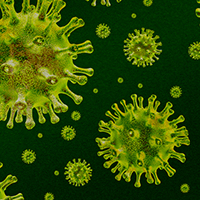Clinical and epidemiological profile of Indian COVID-19 patients from Jaipur: a descriptive study

Submitted: May 13, 2020
Accepted: December 14, 2020
Published: July 21, 2021
Accepted: December 14, 2020
Abstract Views: 1560
PDF: 782
Publisher's note
All claims expressed in this article are solely those of the authors and do not necessarily represent those of their affiliated organizations, or those of the publisher, the editors and the reviewers. Any product that may be evaluated in this article or claim that may be made by its manufacturer is not guaranteed or endorsed by the publisher.
All claims expressed in this article are solely those of the authors and do not necessarily represent those of their affiliated organizations, or those of the publisher, the editors and the reviewers. Any product that may be evaluated in this article or claim that may be made by its manufacturer is not guaranteed or endorsed by the publisher.
Similar Articles
- Valeria Valente, Raffaele Izzo, Maria Virginia Manzi, Maria Rosaria De Luca, Emanuele Barbato, Carmine Morisco, Modulation of insulin resistance by renin angiotensin system inhibitors: implications for cardiovascular prevention , Monaldi Archives for Chest Disease: Vol. 91 No. 2 (2021)
- Gian Francesco Mureddu, Cesare Greco, Stefano Rosato, Paola D'Errigo, Leonardo De Luca, Gabriella Badoni, Pompilio Faggiano, Fulvia Seccareccia, High thrombotic risk increases adverse clinical events up to 5 years after acute myocardial infarction. A nationwide retrospective cohort study , Monaldi Archives for Chest Disease: Vol. 89 No. 3 (2019)
- Naela Ashraf, Suha Zubairi, Mehnaz Atiq, Farheen Ahmed, Muneer Amanullah, Anomalous left coronary artery from pulmonary artery (ALCAPA) as a silent cause of mitral regurgitation in children , Monaldi Archives for Chest Disease: Vol. 93 No. 1 (2023)
- Vinh Nguyen-Nhu, Lam-Phuoc Nguyen, Sy Duong-Quy, Pham Le An, Tri Bui-Minh, Classification of chronic obstructive pulmonary disease as ABCD according to the GOLD 2011 and 2017 versions in patients at the University Medical Center in Ho Chi Minh City, Vietnam , Monaldi Archives for Chest Disease: Vol. 94 No. 2 (2024)
- Filippo Brandimarte, Alessandro Battagliese, Silvana Petronilla Pirillo, Maria Teresa Mallus, Rosa Maria Manfredi, Giovanni Carreras, A case of arrhythmogenic right ventricular cardiomyopathy with biventricular involvement , Monaldi Archives for Chest Disease: Vol. 89 No. 1 (2019)
- Monika Bansal, Komaldeep Kaur, Aditi Gupta, Deepak Goyal, Nidhi Girdhar, Vishal Chopra, Sanjeev Bhagat, Akhil D. Goel, Prevalence of aspergillus skin hypersensitivity in allergic rhinitis , Monaldi Archives for Chest Disease: Vol. 91 No. 3 (2021)
- Prakhar Agarwal, Kranti Garg, Varinder Saini, Isha Singh, Pulmonary rehabilitation: A novel adjunct in management of obstructive sleep apnea , Monaldi Archives for Chest Disease: Vol. 93 No. 1 (2023)
- Miguel Martins Carvalho, Tânia Proença, Ricardo Alves Pinto, Roberto Pinto, Filipe Macedo, Wernicke encephalopathy and beriberi disease presenting as STEMI-equivalent , Monaldi Archives for Chest Disease: Vol. 93 No. 4 (2023)
- Nitish Aggarwal, Tarun Krishna Boppana, Saurabh Mittal, COVID-19 pandemic: The testing times for healthcare workers , Monaldi Archives for Chest Disease: Vol. 91 No. 1 (2021)
- Fulvio Cacciapuoti, Antonio D’Onofrio, Luca Gaetano Tarquinio, Valentina Capone, Ciro Mauro, Raffaele Marfella, Federico Cacciapuoti, Sleep-disordered breathing and heart failure: a vicious cycle of cardiovascular risk , Monaldi Archives for Chest Disease: Vol. 94 No. 2 (2024)
<< < 61 62 63 64 65 66 67 68 69 70 > >>
You may also start an advanced similarity search for this article.

 https://doi.org/10.4081/monaldi.2021.1377
https://doi.org/10.4081/monaldi.2021.1377





